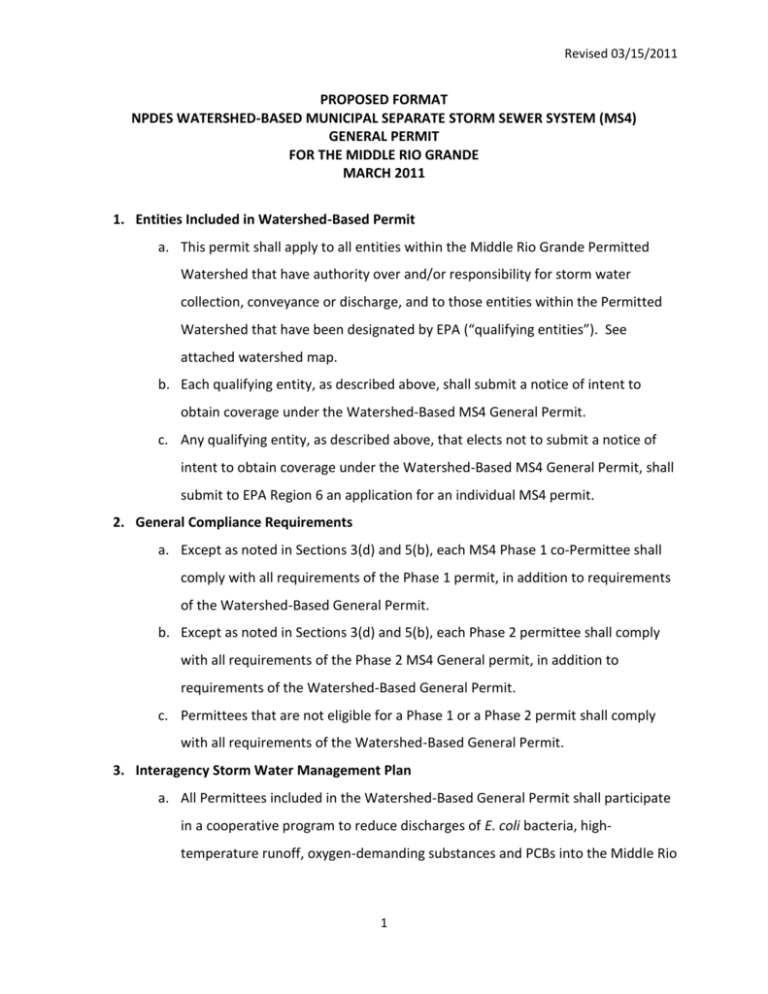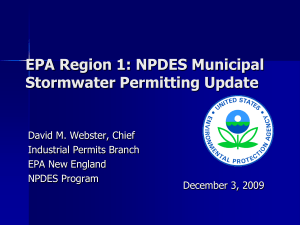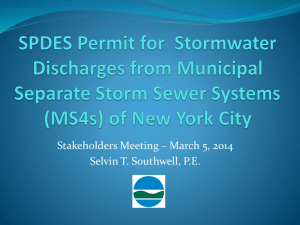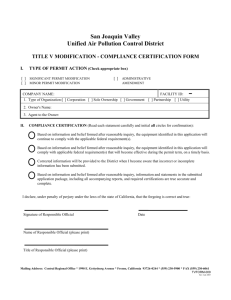Draft Watershed-Based MS4 Permit
advertisement

Revised 03/15/2011 PROPOSED FORMAT NPDES WATERSHED-BASED MUNICIPAL SEPARATE STORM SEWER SYSTEM (MS4) GENERAL PERMIT FOR THE MIDDLE RIO GRANDE MARCH 2011 1. Entities Included in Watershed-Based Permit a. This permit shall apply to all entities within the Middle Rio Grande Permitted Watershed that have authority over and/or responsibility for storm water collection, conveyance or discharge, and to those entities within the Permitted Watershed that have been designated by EPA (“qualifying entities”). See attached watershed map. b. Each qualifying entity, as described above, shall submit a notice of intent to obtain coverage under the Watershed-Based MS4 General Permit. c. Any qualifying entity, as described above, that elects not to submit a notice of intent to obtain coverage under the Watershed-Based MS4 General Permit, shall submit to EPA Region 6 an application for an individual MS4 permit. 2. General Compliance Requirements a. Except as noted in Sections 3(d) and 5(b), each MS4 Phase 1 co-Permittee shall comply with all requirements of the Phase 1 permit, in addition to requirements of the Watershed-Based General Permit. b. Except as noted in Sections 3(d) and 5(b), each Phase 2 permittee shall comply with all requirements of the Phase 2 MS4 General permit, in addition to requirements of the Watershed-Based General Permit. c. Permittees that are not eligible for a Phase 1 or a Phase 2 permit shall comply with all requirements of the Watershed-Based General Permit. 3. Interagency Storm Water Management Plan a. All Permittees included in the Watershed-Based General Permit shall participate in a cooperative program to reduce discharges of E. coli bacteria, hightemperature runoff, oxygen-demanding substances and PCBs into the Middle Rio 1 Revised 03/15/2011 Grande, and to reduce the discharge of nutrients and turbidity-causing substances into Tijeras Creek and Las Huertas Creek. b. The Permittees shall jointly produce a written Interagency Storm Water Management Plan (SWMP). In addition to the elements described in Section 3(d), the interagency SWMP shall address equitable joint funding of activities required by the Watershed-Based Permit, based on population, acreage, impervious area and/or other factors. c. The Interagency SWMP and any future revisions thereto shall be approved in writing by EPA before any version is implemented. d. Participation in the activities defined in the Interagency SWMP shall constitute compliance with corresponding requirements in Phase 1 and Phase 2 MS4 permits. e. The Interagency SWMP shall include implementation programs with measureable goals for the following elements. i. Public Involvement. The Permittees shall conduct joint public meetings to gather information to inform the continued improvement of the InterAgency SWMP. ii. Public Education and Outreach. The Permittees shall jointly fund, design and implement an ongoing education and outreach campaign to, at a minimum, inform the public about the problem of stormwater-borne pollution of the Rio Grande and available control measures for E. coli bacteria, oxygen-demanding substances, nutrients, PCBs and hightemperature runoff. iii. Illicit Discharge Detection and Elimination. 1. The Permittees shall jointly fund, design and implement a program for training field personnel employed by each entity at least annually about illicit discharges to storm sewers. The training shall include information about construction site runoff control required by the USEPA Construction General Permit (CGP) 2 Revised 03/15/2011 and industrial site pollution control measures required by the USEPA Multi Sector General Permit (MSGP) for Industrial Activities. 2. The Permittees shall jointly develop a mechanism by which field personnel can report suspected illicit discharges to storm sewers, or suspected non-compliance with the CGP or the MSGP, and policies and procedures for responding to such reports. 3. Permittees that own and operate MS4s and for which adequate jurisdiction and/or authority exists shall individually adopt rules, ordinances, federal procedures or other instruments, consistent with their respective rulemaking procedures, prohibiting the discharge of substances that contribute to elevated concentrations in stormwater of E. coli bacteria, high temperature runoff, oxygen demanding substances, nutrients or PCBs, and providing an enforcement response plan and penalties for violators. iv. Post-Construction Runoff Control. 1. The Permittees shall individually prepare and adopt development review requirements that require the incorporation of low impact development and green infrastructure principles for new development projects and for redevelopment projects. 2. The Permittees shall jointly coordinate their development review requirements to ensure consistency between jurisdictions. v. Good Housekeeping Practices. 1. The Permittees shall jointly fund, design and implement a program for training operations personnel employed by each entity at least annually about good housekeeping practices that can prevent or reduce pollutant concentrations in stormwater runoff. 3 Revised 03/15/2011 2. Each Permittee shall individually develop an internal auditing program to annually review adherence to good housekeeping practices by their personnel. vi. Watershed-Wide Information Sharing. 1. The Permittees shall jointly fund, design and implement an internet-based tool for sharing information among the Permittees, NMED and EPA. 2. Shared information shall include, but shall not be limited to, permit compliance results and non-proprietary water quality results pertaining to stormwater management. vii. Water quality monitoring. The Permittees shall jointly fund, design and implement a water quality monitoring program, in accordance with the requirements of Section 4. 4. Water Quality Monitoring a. The Permittees shall jointly fund, design and implement a monitoring program to assess progress toward water quality improvement benchmarks within the permitted watershed. b. The joint monitoring program shall not substitute for monitoring requirements included in any existing Phase 1 or Phase 2 MS4 permit. c. Water quality sampling locations, frequencies, parameters and analytical methods shall be specified in the Interagency SWMP, and may be modified by revision of the Interagency SWMP. d. To establish baseline data for attainment of water quality standards, during the first two years of the Watershed-Based MS4 Permit, the Rio Grande shall be monitored as follows. i. Rio Grande water shall be monitored twice each year during non-storm periods and twice each year during storm events at each location for each parameter described below. ii. Rio Grande water shall be monitored at the following locations: 4 Revised 03/15/2011 1. The Angostura diversion structure; 2. The NM Highway 550 Bridge; 3. The Alameda Boulevard Bridge; 4. The Rio Bravo Street Bridge; and 5. The NM Highway 147 Bridge. iii. Rio Grande water shall be tested for concentrations of E. coli bacteria, PCBs and oxygen-demanding substances, and water temperatures shall be determined. Analytical methods specified in the latest revision of 40CFR Part 136 shall be used, except that EPA Method 1668C shall be used to determine PCB concentrations. e. To establish baseline data for attainment of water quality standards, during the first two years of the Watershed-Based Permit, Las Huertas Creek shall be monitored as follows. i. Las Huertas Creek water shall be sampled at its junction with NM 165 near Placitas, or at the nearest upstream perennial section, once per calendar quarter. ii. Las Huertas Creek water shall be tested for turbidity and for concentrations of total Kjeldahl nitrogen, nitrate nitrogen and total phosphorus, using analytical methods specified in the latest revision of 40CFR Part 136. f. To establish baseline data for attainment of water quality standards, during the first two years of the Watershed-Based Permit, Tijeras Creek shall be monitored as follows. i. Tijeras Creek water shall be sampled at or near A. Montoya Elementary School in Tijeras four times per year during storm events. ii. Tijeras Creek water shall be tested for concentrations of total Kjeldahl nitrogen, nitrate nitrogen and total phosphorus, using analytical methods specified in the latest revision of 40CFR Part 136. 5 Revised 03/15/2011 5. Reporting a. The Permittees shall jointly submit an annual report to EPA. i. The annual report shall detail activities, accomplishments and measurable outcomes for activities listed in the Interagency SWMP, for each Permittee. ii. The annual report shall include the results of water quality monitoring described in Section 4. iii. For any requirements not met during the reporting period, the annual report shall include a corrective action plan for achieving compliance. b. The joint annual report required by Section 5 shall not substitute for reporting requirements included in Phase 1 and Phase 2 MS4 permits. However, Phase 1 and Phase 2 MS4 permit annual reports may reference the Watershed-Based General Permit annual report for compliance purposes, as described in Section 3(d). 6. Enforcement a. The annual report required in Section 5 shall be the basis for determining that each individual Permittee has fulfilled its responsibilities under the Inter-Agency SWMP required in Section 3. b. Each Permittee shall be individually subject to enforcement for failure to fulfill its responsibilities under the Inter-Agency SWMP required in Section 3. 6 Revised 03/15/2011 WATERSHED MAP 7





